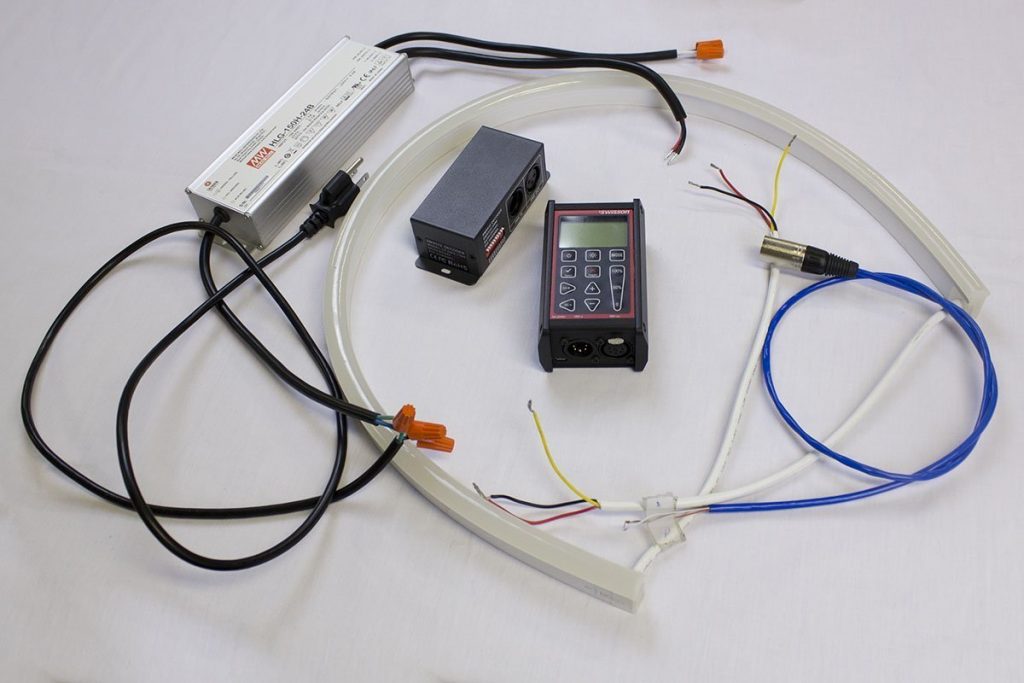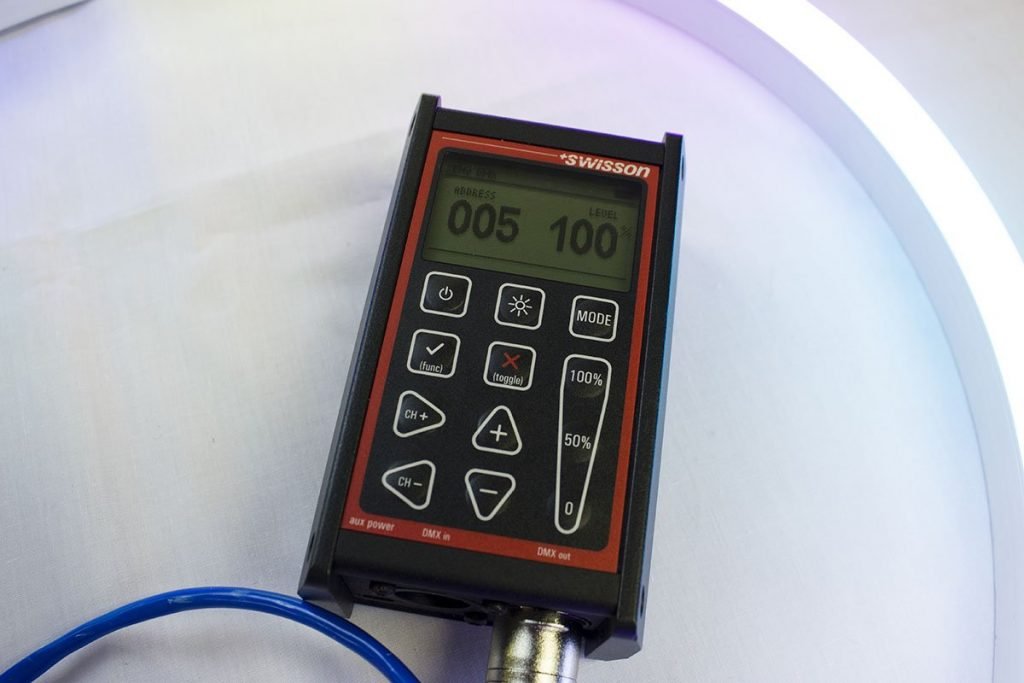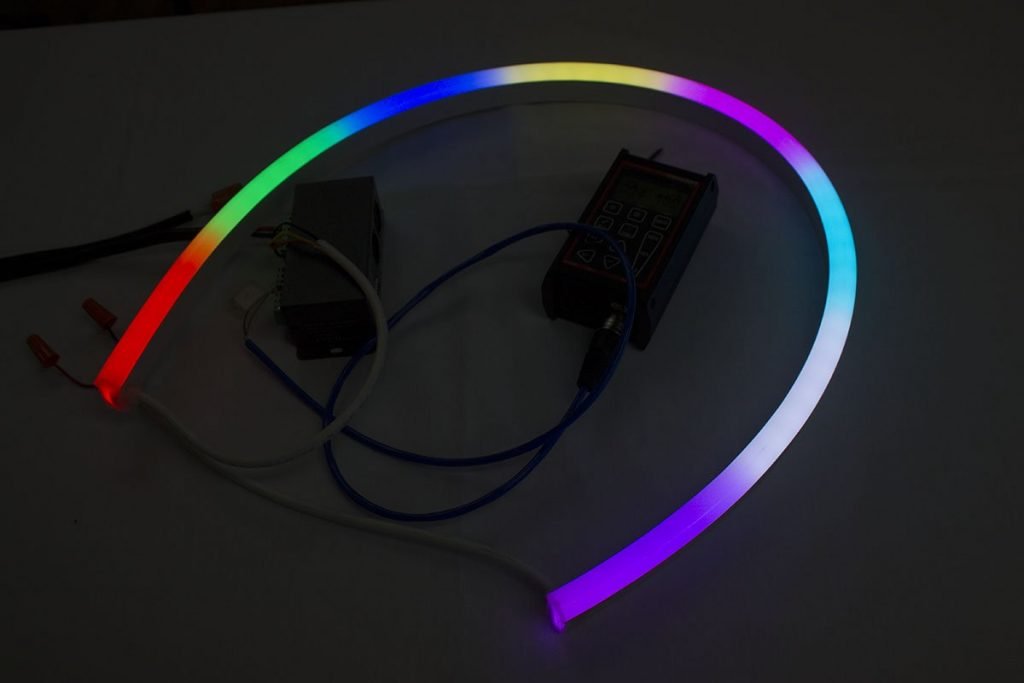In our last Tech Talk, we covered testing resistance with a multimeter and ringing out pins.
This week, we’re going to cover testing a Vivid Pixel fixture with a DMX tester. This is an important step to go through before installing your fixture! You want to be sure everything works before starting the installation.
The Testing Setup

Products:
- 3 Wire Vivid Pixel LED Neon Flex fixture (with seamless ends)
You’ll notice our sample piece has two lead wires. This wiring also applies to any Vivid Pixel fixture, and is being set up only on the signal input lead. - DMX 512 LT-DMX-1809
- Swisson DMX Tester
- 2/5mm screw driver
Please note: GLLS does not sell DMX testers. We purchased ours online.
DMX Decoder Testing Mode
When working with a fixture that has two lead wires, be aware of the signal input direction.

The marker arrow on the side of your fixture indicates the signal direction. Always make sure you’re wiring to the signal input lead.
To test your Vivid Pixel fixture with the DMX Testing mode, follow the instructions in our Vivid RGB post. The DMX decoder alone won’t allow you to test individual pixels, but it will control the entire fixture as though it were RGB. The DMX tester is necessary to test individual pixels.
Setting Up The DMX Tester
After you ring out the pins of your DMX tester, you’re ready to hook it into your DMX decoder.

To connect your DMX tester to the decoder, you’ll be using the DMX IN section. Connect your + wire to A, your – wire to B and your ground wire to G.
Now that we’re all hooked up, we’re ready to start testing!
Testing Vivid Pixel
Please note: Unless you connect to a PC, you will not be able to program or test any animations such as a chase. We will cover this in a later post
Turn your DMX tester on. Go to the “Send DMX” option to change the color of your pixels.

Every pixel on your fixture occupies 3 channels (R, G, B). The first pixel on your fixture, for example, is controlled by channel 001, 002, and 003.
To get to the second pixel, you would press CH+ until you reach 004. The second pixel is controlled by 004, 005, and 006. This pattern continues for every pixel on your fixture.
The following functions work on our Swisson DMX Tester. Other testers may be different, so always read your manual!
When your DMX tester is on channel 001…
- Press CH- once: it will take you to “all channels”. This allows you to control the full fixture at one time.
- Press CH- twice: every 3rd channel +2. This sets your fixture to blue.
- Press CH- three times: every 3rd channel +1. This sets your fixture to green.
- Press CH- four times: every 3rd channel. This sets your fixture to red.
Anything past this is 4 channel RGBW, which we’ll cover in the future.
With your DMX tester’s percentage buttons, you can quickly set your channels to 100%, 50%, or 0%. Otherwise, you can set very specific colors using the + and – arrows and inputing an RGB codes percentages.
To figure out the percentages of your RGB codes, divide each color code by 255 and multiply that result by 100. So, as an example, if you wanted to set your first pixel to R66 G220 B244, you would set channel 001 to 26% ((66/255)x100), channel 002 to 86% ((220/255)x100), and channel 003 to 96% ((244/255)x100).
Here’s an example we made up:

We’ve programmed 8 pixels. The first pixel is the red one.
Pixel 1: CH 001 at 100%
Pixel 2: CH 005 at 100%
Pixel 3: CH 009 at 100%
Pixel 4: CH 010 at 100%, CH 011 at 100%
Pixel 5: CH 013 at 100%, CH 015 at 100%
Pixel 6: CH 017 at 100%, CH 018 at 100%
Pixel 7: CH 019 at 100%, CH 020 at 100%, CH 021 at 100%
Pixel 8: CH 022 at 100%, CH 024 at 100%


